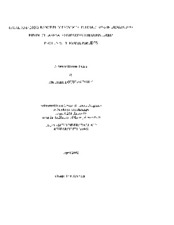| dc.creator | Daily, Michael Douglas | |
| dc.date.accessioned | 2013-02-22T20:41:42Z | |
| dc.date.available | 2013-02-22T20:41:42Z | |
| dc.date.created | 2002 | |
| dc.date.issued | 2013-02-22 | |
| dc.identifier.uri | https://hdl.handle.net/1969.1/ETD-TAMU-2002-Fellows-Thesis-D3314 | |
| dc.description | Due to the character of the original source materials and the nature of batch digitization, quality control issues may be present in this document. Please report any quality issues you encounter to digital@library.tamu.edu, referencing the URI of the item. | en |
| dc.description | Includes bibliographical references (leaf 26). | en |
| dc.description.abstract | The folding of proteins into three-dimensional, biologically active conformations demands much study because protein misfolding causes many genetic diseases and because protein folding is an integral step in translating the code of DNA into the chemistry of life. While folded states of proteins are well studied, their unfolded counterparts have received little attention, partly because for many years, biochemists have treated unfolded states as unstructured. However, multiple recent studies on pH dependence of protein stability have highlighted substantial electrostatic structure in the denatured states of many proteins. To increase understanding of such electrostatic structure, unstructured pentapeptides have been used as models of the ionization behavior of a total of fourteen aspartates, glutamates, and histidines in a hypothetical random-coil conformation of the simple protein RNase Sa. The pK[a]s of the residues of interest in the model peptides have already been compared the intrinsic pK[a]s determined in control pentapeptides for the same residues to determine how local structure perturbs the ionization equilibrium of each ionizable residue from that residue's intrinsic pK[a]. In addition, it was planned to compare the model peptide pK[a]s to the corresponding pK[a]s in denatured RNase Sa to determine how any nonrandom structure in denatured RNase Sa further perturbs the ionization properties of each residue studied. Furthermore, these fourteen peptides will be used as RNase Sa-specific approximations of the denatured state of RNase Sa for pH-dependent free energy of folding calculations for RNase Sa. Previous calculations that used the intrinsic pK[a]s derived from generic model peptides for this approximation agreed poorly with experimentally determined *G[folding] values. This study has found that out of fourteen ionizable residues researched, seven were perturbed by ±0.1 or more from intrinsic pK[a] values. However, comparison of the denatured state of RNase Sa with model compounds has not yet been achieved because of problems gathering pK[a]s for twelve of the fourteen residues in the denatured state. Some new approaches are presently being tried to acquire RNase Sa denatured state pKas for the fourteen ionizable residues. No calculations of pH-dependent *G[folding] values for RNase Sa using the protein-specific model compounds have yet been performed. | en |
| dc.format.medium | electronic | en |
| dc.format.mimetype | application/pdf | |
| dc.language.iso | en_US | |
| dc.publisher | Texas A&M University | |
| dc.rights | This thesis was part of a retrospective digitization project authorized by the Texas A&M University Libraries in 2008. Copyright remains vested with the author(s). It is the user's responsibility to secure permission from the copyright holder(s) for re-use of the work beyond the provision of Fair Use. | en |
| dc.subject | life sciences I. | en |
| dc.subject | Major life sciences I. | en |
| dc.title | Local and long-range electrostatic interactions in denatured Ribonuclease Sa: comparing the denatured protein with model peptides | en |
| thesis.degree.department | life sciences I | en |
| thesis.degree.discipline | life sciences I | en |
| thesis.degree.name | Fellows Thesis | en |
| thesis.degree.level | Undergraduate | en |
| dc.type.genre | thesis | en |
| dc.type.material | text | en |
| dc.format.digitalOrigin | reformatted digital | en |


